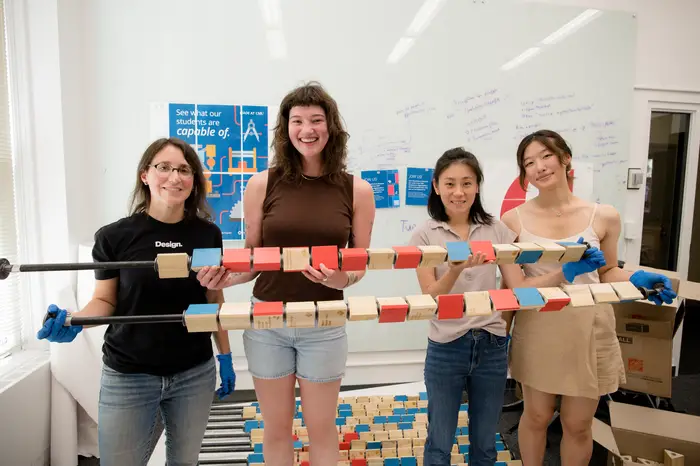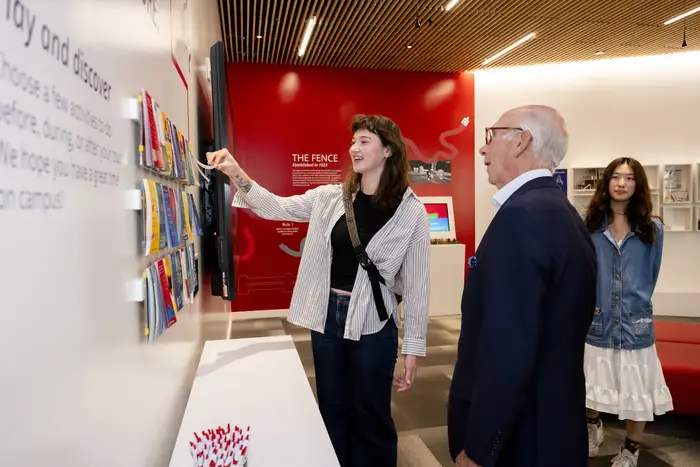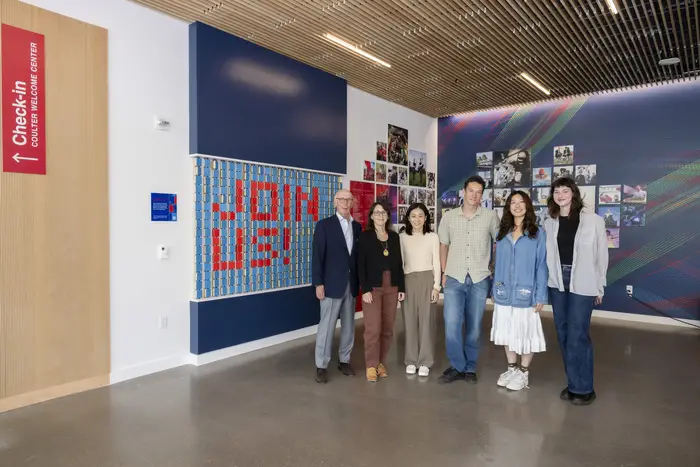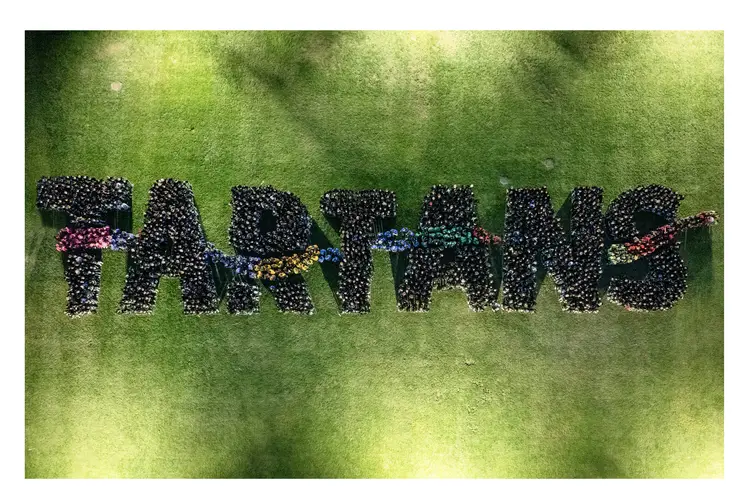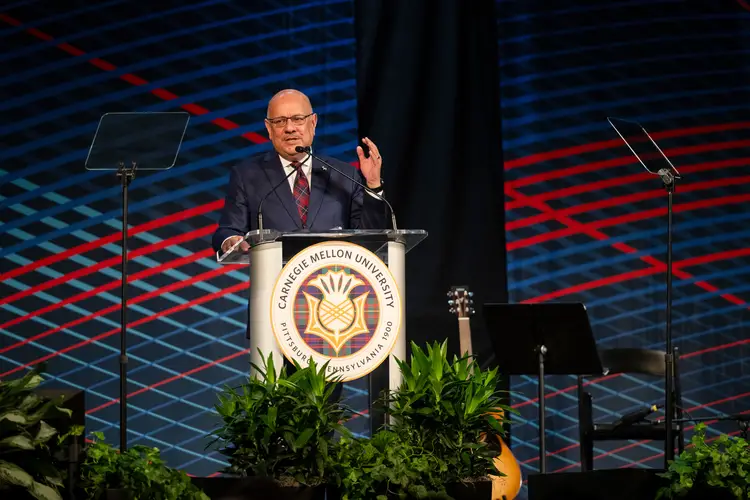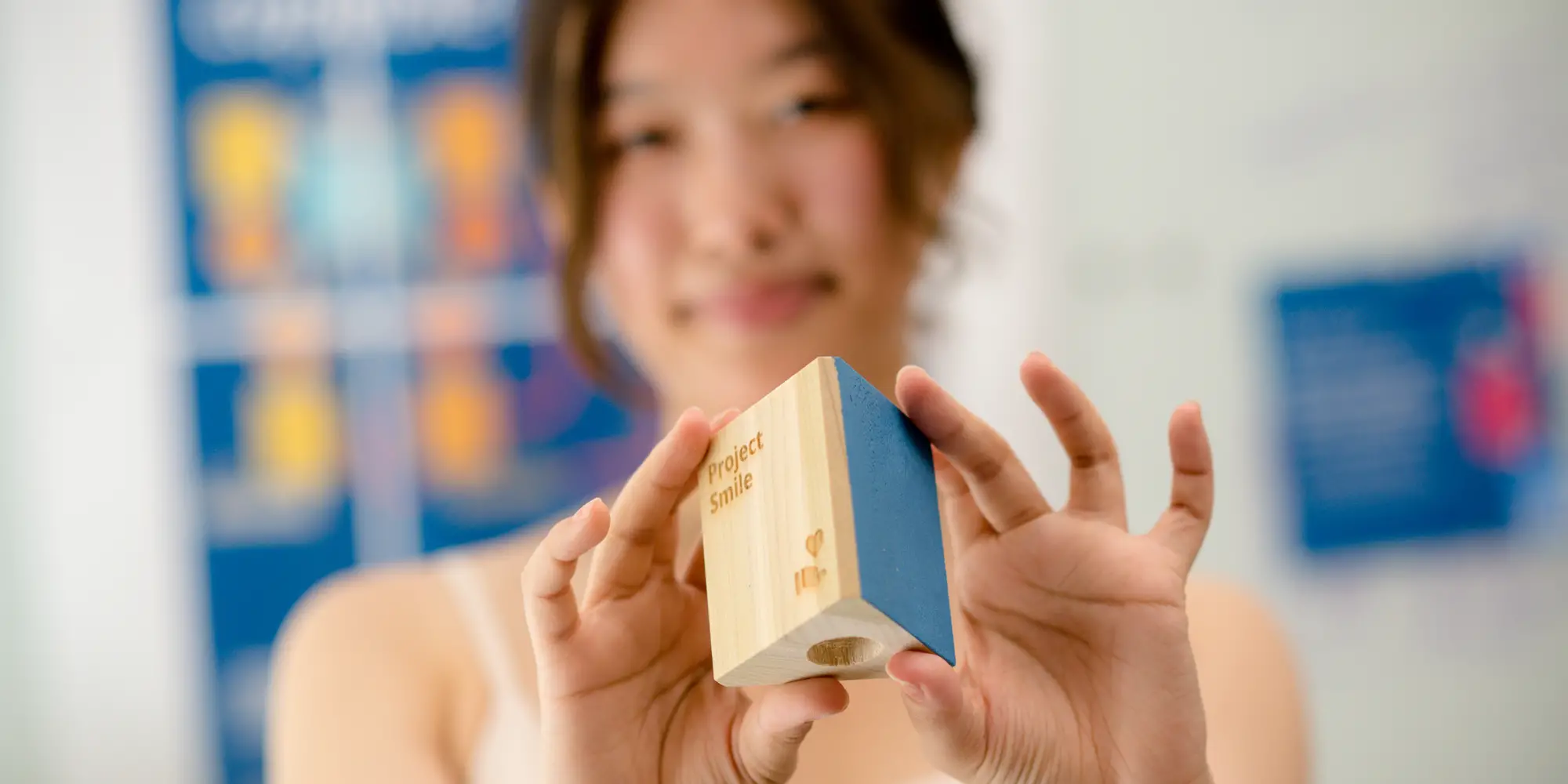
Design Students, Ballay Center Contribute to Coulter Welcome Center Updates
Media Inquiries
From a distance, a new installation in the David and Susan Coulter Welcome Center(opens in new window) invites visitors to Carnegie Mellon University to “Join Us,” spelled out in Scots Rose(opens in new window).
Upon closer inspection, the letters are formed by individual blocks, each of which rotates to reveal the name of one of nearly 400 student organizations at the university.
Helen Zhang (CFA ‘25) and Hannah Lesser (CFA ‘24) assembled the 368 blocks on 23 pipes aligned together, adding washers and bearings in between the triangular blocks.
Updates to the Coulter Welcome Center on the first floor of the Tepper Building(opens in new window) originated in a graduate design class with the goal of fostering a sense of belonging through active, engaging exhibits to showcase the university’s strengths beyond academics. The student-led effort is a collaboration among the Provost’s Office, the School of Design and the Joseph Ballay Center for Design Fusion(opens in new window) in the College of Fine Arts, University Communications and Marketing, and Enrollment Management.
“We spent a good amount of time considering what prospective students and visitors could gain from interacting with the space,” said Zhang, a senior BXA(opens in new window) student studying design and film/visual media studies. “We wanted to make a unique tactile experience you can’t get from a website, and a story that really does show what it’s like at CMU past the academic standing and prestige.”
A touch of CMU creates a lasting first impression
Zhang, Lesser, and Felix Cooper, a senior also studying design, worked over the summer to refresh the Coulter Welcome Center.
“I believe that first impressions are lasting so creating a good first impression is important, and creating an authentic first impression makes it feel more rewarding,” said Lesser, who graduated with a bachelor's degree in design in the spring.
The team solicited many stakeholders’ input to capture Carnegie Mellon’s culture and spirit — something Lesser said it took time to understand fully.
“There are things that you only learn by going to Carnegie Mellon for four years: the experience of the culture of the place,” she said. “We have school spirit, and it just presents itself in a different way than other schools. Trying to prime prospective students earlier will set them up to better understand CMU.”
An interactive miniature of The Fence(opens in new window) allows visitors to move a model paintbrush to trigger a change in a monitor showcasing photos of the CMU landmark.
“There’s a delight in that, where it’s not just clicking or touching a screen, but there’s something physical that triggers a digital interaction,” said Daphne Peters(opens in new window), associate teaching professor in the School of Design(opens in new window). Peters led the student team along with Haeyoung Kim(opens in new window), assistant professor in the School of Design, and they co-taught a graduate design studio course that examined elements of the Center as its course project.
Several paper activity pads in another display each feature a different CMU-centric design where visitors can tear off a sheet and decorate a buggy(opens in new window), design a scarf for Scotty, solve a word scramble about famous CMU alumni, or try a Kraus Campo(opens in new window) sudoku puzzle.
A glass case integrated into a new reception desk entices visitors with merchandise from the University Stores(opens in new window), helping them imagine themselves as future Tartans.
More than 40 people were included in the project, including several departments across campus who reviewed the designs.
“It was really eye-opening to see how much goes into the decision-making and production of everything on campus,” Cooper said.
Project shows how partnerships fuel design fusion
The idea for the new displays began with the Provost’s Office in September 2023. A multitiered integrative effort unified the graduate studio class with professional education workshops through the Joseph Ballay Center for Design Fusion.
The students in the Master of Design program(opens in new window) conducted research and developed concepts under the direction of professors Peters and Kim that led to the design-build summer project.
Then, stakeholders from different departments at CMU participated in workshops to closely examine each aspect of the Coulter Welcome Center.
The workshops also served as a relaunch of the Ballay Center’s professional education sessions(opens in new window), piloting it internally within the university, with this specific series exploring strategic innovation through design.
Mark Baskinger(opens in new window), professor in the School of Design and director of the Ballay Center, said plenty of Carnegie Mellon’s historic firsts are empowered by design.
“When great ideas happen and you add design to it, they gain traction in a way that hits society and popular culture then finds new accessibility,” he said. “Design fusion is about transdisciplinary partnerships to discover new ways of working, new outcomes and new opportunities. It leads to interesting questioning and discovery, and that’s when we know we’ve done our jobs.”
Any ideas also had to consider and incorporate practicalities regarding cost, efficiency, technology and maintenance in addition to the way visitors needed to be drawn to engage with an often otherwise passive space.
With all the design input in mind, the team presented two final design directions in June to university leadership, and their final design proposal to the university’s Design Review Committee in July. Zhang said the final project reviews given across campus were encouraging.
“I was surprised how open everyone was to our ideas,” she said. “Everything ended up working together — nothing was really working against us except for time.”
The three students represent each of the three tracks in the School of Design — Zhang studying environments(opens in new window), Cooper studying products(opens in new window) and Lesser studying communications(opens in new window) — and complemented each other well, Kim said.
“Everyone had different roles, but in the end, they all came together,” she said. “Regardless of their expertise, they were willing to work and make this come to life.”
